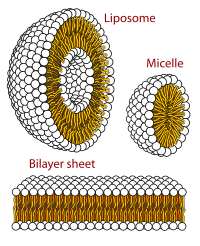
Normal and shear forces between surfaces bearing phosphocholinated polystyrene nanoparticles
Sign Up to like & getrecommendations! Published in 2017 at "Polymers for Advanced Technologies"
DOI: 10.1002/pat.3859
Abstract: Extending earlier studies where phosphocholinated brushes and phosphocholine-exposing phosphatidylcholine lipid bilayer vesicles (PC-liposomes) were shown to be very efficient boundary lubricants in aqueous media by virtue of the highly-hydrated phophocholine groups, we examined interactions between… read more here.
Keywords: bearing phosphocholinated; surfaces bearing; normal shear; phosphocholinated polystyrene ... See more keywords

Polystyrene nanoparticles: Sources, occurrence in the environment, distribution in tissues, accumulation and toxicity to various organisms.
Sign Up to like & getrecommendations! Published in 2020 at "Environmental pollution"
DOI: 10.1016/j.envpol.2020.114297
Abstract: Civilization development is associated with the use of plastic. When plastic was introduced to the market, it was assumed that it was less toxic than glass. Recently, it is known that plastics are serious ecological… read more here.
Keywords: plastic; nps; nanoparticles sources; environment ... See more keywords

Polystyrene nanoparticles as a flotation collector: A molecular dynamics study
Sign Up to like & getrecommendations! Published in 2019 at "Journal of Molecular Liquids"
DOI: 10.1016/j.molliq.2018.11.062
Abstract: Abstract Nanoparticles have significant potential as new candidates for generating new types of flotation reagents with unique performance for wettability design and control. Hence, this study explores the wettability of a glass surface covered with… read more here.
Keywords: polystyrene nanoparticles; surface; molecular dynamics; glass surface ... See more keywords

Cellular Process of Polystyrene Nanoparticles Entry into Wheat Roots.
Sign Up to like & getrecommendations! Published in 2022 at "Environmental science & technology"
DOI: 10.1021/acs.est.1c08503
Abstract: Nanoscale plastic particles are widely found in the terrestrial environment and being increasingly studied in recent years. However, the knowledge of their translocation and accumulation mechanism controlled by nanoplastic characterizations in plant tissues is limited,… read more here.
Keywords: process polystyrene; cellular process; polystyrene nanoparticles; size ... See more keywords

Surface-Functionalized Polystyrene Nanoparticles Alter the Transmembrane Potential via Ion-Selective Pores Maintaining Global Bilayer Integrity
Sign Up to like & getrecommendations! Published in 2022 at "Langmuir"
DOI: 10.1021/acs.langmuir.2c02487
Abstract: Although nanoplastics have well-known toxic effects toward the environment and living organisms, their molecular toxicity mechanisms, including the nature of nanoparticle–cell membrane interactions, are still under investigation. Here, we employ dynamic light scattering, quartz crystal… read more here.
Keywords: surface functionalized; bilayer; polystyrene nanoparticles; functionalized polystyrene ... See more keywords

Tuning Morphologies and Reactivities of Hybrid Organic-Inorganic Nanoparticles.
Sign Up to like & getrecommendations! Published in 2022 at "ACS nano"
DOI: 10.1021/acsnano.2c04585
Abstract: Hybrid nanoparticles (hNPs), or nanoparticles composed of both organic and inorganic components, hold promise for diverse energy and environmental applications due to their ability to stabilize reactive nanomaterials against aggregation, enhancing their ability to pervade… read more here.
Keywords: tuning morphologies; reactivities hybrid; morphologies reactivities; organic inorganic ... See more keywords

DNA-Immobilized Fluorescent Polystyrene Nanoparticles as Probes with Tunable Detection Limits
Sign Up to like & getrecommendations! Published in 2022 at "ACS Omega"
DOI: 10.1021/acsomega.2c06498
Abstract: DNA-immobilized nanoparticle probes show high target specificity; thus, they are employed in various bioengineering and biomedicine applications. When the nanoparticles employed are dye-loaded polymer particles, the resulting probes have the additional benefit of biocompatibility and… read more here.
Keywords: fluorescent polystyrene; detection; dna immobilized; polystyrene nanoparticles ... See more keywords

Implementation of the emulsification-diffusion method by solvent displacement for polystyrene nanoparticles prepared from recycled material
Sign Up to like & getrecommendations! Published in 2021 at "RSC Advances"
DOI: 10.1039/d0ra07749f
Abstract: From an integral perspective, nanotechnology can be used to care for the environment by improving current preparation methods and facilitating industrial scale-up. This article discusses the implementation of techniques for obtaining polystyrene nanoparticles (PSN), as… read more here.
Keywords: solvent displacement; polystyrene nanoparticles; diffusion; methodology ... See more keywords

Amino-modified polystyrene nanoparticles affect signalling pathways of the sea urchin (Paracentrotus lividus) embryos
Sign Up to like & getrecommendations! Published in 2017 at "Nanotoxicology"
DOI: 10.1080/17435390.2017.1279360
Abstract: Abstract Polystyrene nanoparticles have been shown to pose serious risk to marine organisms including sea urchin embryos based on their surface properties and consequently behaviour in natural sea water. The aim of this study is… read more here.
Keywords: embryos; sea; paracentrotus lividus; sea urchin ... See more keywords

Prevention of urinary infection through the incorporation of silver–ricinoleic acid–polystyrene nanoparticles on the catheter surface
Sign Up to like & getrecommendations! Published in 2021 at "Journal of Biomaterials Applications"
DOI: 10.1177/0885328220983552
Abstract: Nosocominal infections associated with biofilm formation on urinary catheters cause serious complications. The aim of this study was to investigate the feasibility of the polyurethane (PU) catheter modified with tetracycline hydrochloride (TCH) attached Ag nanoparticles… read more here.
Keywords: acid polystyrene; prici; prici nps; agnps prici ... See more keywords

Effects of polystyrene nanoparticles on the microbiota and functional diversity of enzymes in soil
Sign Up to like & getrecommendations! Published in 2018 at "Environmental Sciences Europe"
DOI: 10.1186/s12302-018-0140-6
Abstract: BackgroundThe increasing production of nanoplastics and the fragmentation of microplastics into smaller particles suggest a plausible yet unclear hazard in the natural environment, such as soil. We investigated the short-term effects (28 days) of polystyrene nanoparticles… read more here.
Keywords: microbiota functional; functional diversity; soil; incubation period ... See more keywords